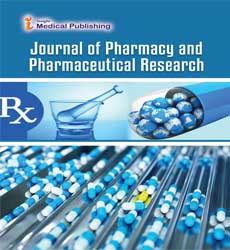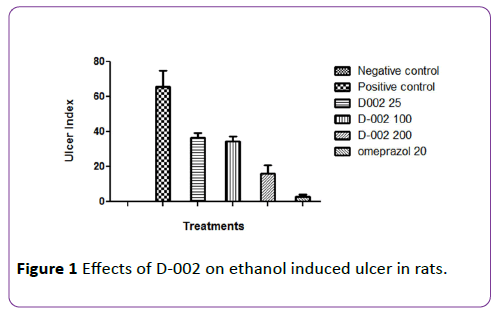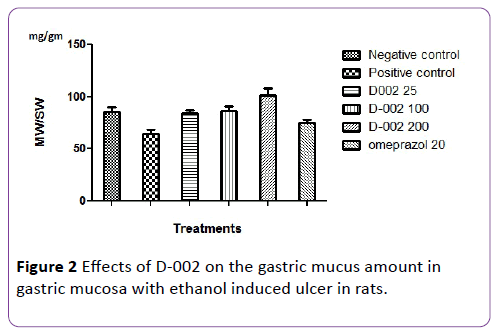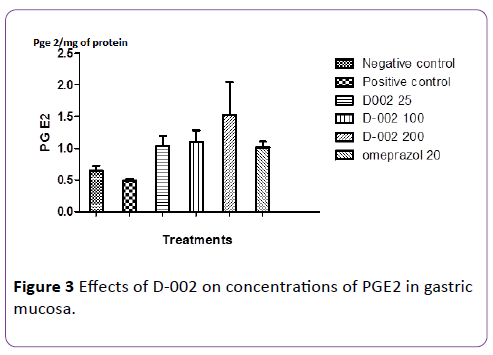Keywords
D-002; Ethanol induced-gastric ulcer;
Prostaglandin E2
Introduction
Peptic ulcer is a chronic relapsing disease of the
gastrointestinal tract which can be gastric or duodenal [1]. It is
very common in the adult population and its major
complications (bleeding, perforation, penetration and
obstruction) lead to a significant impact on quality of life of
sufferers [2]. The ulcer is defined as an interruption of the
extended mucosa through the muscularis mucosae until inside
the submucosa [3] and it occurs due to imbalance between
aggressive (nonsteroidal acid secretion, pepsin, H. pylori, antiinflammatory
-AINEs-) and defensive factors (mucus secretion
and bicarbonate, microcirculation, -PG- prostaglandins, growth
factors) acting on the mucosa gástrica [4-7]. Thus, when a
weakening of defense factors or the action of aggressive factors
exceeds the defensive capacity of the gastric mucosa peptic
ulcer occurs [8]. In this context, it has been documented the
important role of prostaglandin E2 (PGE2), the most abundant
PG of the gastrointestinal tract, in gastric cytoprotection through
a multifactorial mechanism that involves regulation of the
secretion of gastric mucus, acid secretion and gastric motility
[9-12], and inhibition of release of free radicals from the
neutrophils [13]. Another mechanism involved in gastric
cytoprotection exerted by PGE2 is the inhibition of apoptosis
induced by irritants agents in gastric mucosal cells, through
activation of the enzyme protein kinase A and the subsequent
increase in cAMP levels [14].
Therefore, the removal of PGE2 in the gastric mucosa
represents an important etiological factor in the development
and progression of peptic ulcer. This effect is produced among
other causes by eating anti-inflammatory drugs (NSAIDs) widely
used to treat acute and chronic inflammatory disorders [15], as
their mode of action is based on inhibition of the activity of the
enzyme cyclooxygenase (COX) which leads to the inhibition of
PGs synthesis [16]. Consequently, the high prescription of
NSAIDs for managing the osteoarthritis, one of the most
common chronic diseases of the elderly [17], in the prevention
of cardiovascular and cerebrovascular diseases [18] and in the
chemoprevention of certain cancers [19] it has become in the most common etiological factor for the development of peptic
ulcer [15].
On the other hand, it has been described that the
gastroprotective effects of some substances that increase the
gastric mucus secretion is associated with increased
concentrations of PGE2 in gastric mucosa [20,21].
Therefore, the search for new substances with potential
stimulatory effect of PGE2 formation to strengthen the defense
of the gastric mucosa against the action of NSAIDs is a topic of
interest.
D-002 is a mixture of six aliphatic primary alcohols of higher
molecular weight, isolated and purified from beeswax (Apis
mellifera), whose principal component is triacontanol followed
by hexacosanol, octacosanol, tetracosanol, dotraicontanol and
tetratriacontanol [22].
D-002 produces anti-inflammatory, antioxidant and
gastroprotective effects, demonstrated in experimental and
clinical studies [23-35]. The gastroprotective effects of D-002
have been evaluated in models of gastric ulcers induced in rats
by ethanol [24,25], stress[24], aspirin [26,27], indomethacin
[28,29], ibuprofen, naproxen [30], pylorus ligation [31], acetic
acid [32], and ischemia reperfusión [28] and have been
associated with a cytoprotective multifactorial mechanism that
involves improving the quality and increasing of the gastric
mucus secretion, its antioxidant action on gastric mucosa and
dependent effects of prostaglandins (PG) [28,29,31,33,34].
The antioxidant action of D-002 on gastric mucosa is
supported by a mechanism that involves sequestering hydroxyl
radical and stimulating enzymes activities of endogenous
antioxidant system in gastric mucosa (catalase, superoxide
dismutase and glutathione peroxidase) [29,34].
Moreover, although it is known that the gastroprotective
action of D-002 is dependent on PGs [31] still is unknown
whether D-002 modifies the values of PGE2 in gastric mucosa.
Therefore, this study was undertaken for investigating the
effects of D-002 on PGE2 concentrations in gastric mucosa with
ethanol induced ulcer in rats.
Materials and Methods
Animals
Male Sprague Dawley rats (250-300 gm) from the National
Center for Laboratory Animal Production (CENPALAB, Havana,
Cuba) were used for the study and adapted for 7 days to the
following conditions: temperature (22-23oC), relative humidity
(55-60%) and 12 hours’ dark/light cycles. Food and water were
freely supplied. The animals had fasted for 24 hours prior to the
experiments.
The experiments were performed in accordance with the care
and use of experimental animals prescribed by the Cuban
Guidelines for the care of laboratory animals and the Cuban
Code of Good Laboratory Practice (GLP), after obtaining the
approval of the Institutional Board for animal use.
Administration and dosage
The batch of D-002 (030151211), supplied by the Plants of
Natural Products (National Center for Scientific Research,
Havana City, Cuba) was used after corroborate its quality criteria.
Batch composition, assessed with a validated gas
chromatographic method [35], was as follows: 1-tetracosanol
(5%), 1-hexacosanol (10.2%), 1-octacosanol (14%), 1-
triacontanol (34.21%), 1-dotriacontanol (24.24%) and 1-
tetratriacontanol (3.03%). Purity (total content of these alcohols)
was 90.7%.
D-002 was prepared as a suspension in Tween 20/H2O vehicle
(2%) and omeprazole (batch: 0912027, Pharmaceutical Cuban,
Havana, Cuba) in a suspension in an acacia/water vehicle (1%).
Rats were randomized into six groups (10 rats/group): a
negative control that only received the vehicle and five groups
with ethanol induced gastric ulcer: a positive control (vehicletreated),
three treated with D-002 (25, 100 and 200 mg/kg) and
one with omeprazole (20 mg/kg) as a reference substance.
All treatments (vehicle, D-002 and Omeprazol) were
administered orally by gastric gavage (5 ml/kg) as single doses
one hour before gastric ulcer induction.
Ethanol induced gastric ulcer induction in rats
The rats were fasted 24 hours before the experiment with free
access to water. We proceeded according to Zengil et al. [36].
One hour after administration of single dose of the vehicle,
D-002 (25, 100 and 200 mg/kg) and omeprazole (20 mg/kg),
each rat received 60% ethanol (1 mL/200 g) by intubation
gastric. One hour later the rats were sacrificed under an
overdose of thiopental anesthesia and the stomachs were
extracted, weighed in rapid Mettler Toledo balance, opened by
greater curvature and the mucus was obtained by careful
scraping with a scalpel. Subsequently the stomachs were
washed in saline and ulcer index was measured.
Determination of the gastric mucus amount
Gastric mucus was collected, weighed and the amount of
mucus was expressed as the ratio of the weight of mucus (mg)/
stomach weight (g).
Quantitation of concentrations of PGE2 in gastric
mucosa
For quantification of PGE2 concentrations gastric mucus was
homogenized in saline phosphate buffer (PBS) at 4oC (125 mg
tissue/ml PBS). The homogenate was centrifuged at 4500 rpm
for 15 minutes at 4oC and the supernatant was used for
determination of PGE2 levels by ELISA (R&D Systems)
commercial kit and total protein concentrations by the method
of Lowry modified [37]. PGE2 values were expressed as PGE2
ng/mg protein.
Evaluation of gastric ulceration
The lesions in the gastric mucosa were examined
macroscopically using magnification 3X. Ulcer indexes were determined as the sum of the lengths of the whole gastric
lesions (in mm). Two independent, blinded observers performed
the observations and measurements of lesion lengths [38].
Statistical Analyses
Comparisons among groups were done with the Kruskal Wallis
test; paired comparisons between each treated and control
groups with the Mann-Whitney U test. Statistical significance
was chosen for α=0.05. Data were processed with the Statistics
Software for Windows (Release 6.1 Stat Soft Inc, Tulsa OK, USA).
The study of dose-effect relationship was performed by the
method of linear regression and correlation using the Primer of
Biostatistics (Stanton A Glantz, version 3.01) program.
Results
Table 1 followed by the Figure 1 show the results of the
effects of single oral doses of D-002 on the gastric ulcers index
induced by ethanol in rats. Oral administration of ethanol
produced a significant gastric ulceration in animals of the
positive control group compared with the negative control
group, which did not present any ulceration. Oral administration
with D-002 (25, 100 and 200 mg/kg) markedly, significantly and
non-dose dependently prevented the ulcer index formation
(44.4; 47.8 and 75.2% of inhibition, respectively) compared with
the positive control group. The omeprazole reference drug (20
mg/kg), significantly and markedly inhibited the gastric ulcer
index (95.8%) respect to the positive control group,
corroborating the validity of these results in our experimental
conditions.
| Groups |
Doses
(mg/kg) |
Ulcer Index
(mm) |
I
(%) |
| Negative control |
__ |
0 ± 0 **** |
__ |
| Positive Control |
__ |
65.7 ± 9.09 |
__ |
| D-002 |
25 |
36.5 ± 2.67 * |
44.4 |
| D-002 |
100 |
34.3 ± 3.03 * |
47.8 |
| D-002 |
200 |
16.26 ± 4.48 *** |
75.2 |
| Omeprazole |
20 |
2.77 ± 1.15 *** |
95.8 |
I (%): Percent Inhibition, *p<0,05; ***p<0,001;****p<0,001 Comparison with positive control, (Mann Whitney U test)
Table 1: Effects of D-002 on ethanol induced ulcer in rats.
Figure 1: HPLC chromatogram of the nine reference compounds in 50% aqueous methanol, measured at 370nm. Retention times for rutin, sutherlandin A, sutherlandin B, kaempferol-3-O-rutinoside, sutherlandin C, sutherlandin D, quercitrin, quercetin and kaempferol were 11.9, 12.7, 13.8, 15.3, 16.2, 17.0, 18.0, 26.2 and 28.1 minutes, respectively.
Figures 2 and 3 shows the results of the effects of D-002 on
the amount of gastric mucus and PGE2 concentrations in gastric
mucosa, respectively (Table 2). Oral administration of ethanol
significantly reduced the gastric mucus content (expressed as
mucus weight/stomach weight) and concentrations of PGE2 in
gastric mucosa (expressed as ng of PgE2/mg of protein) in
animals of the positive control group compared with the
negative control group.
Figure 2: Effects of D-002 on the gastric mucus amount in
gastric mucosa with ethanol induced ulcer in rats.
Figure 3: Effects of D-002 on concentrations of PGE2 in gastric
mucosa.
| Groups |
Doses
(mg/kg) |
MW/SW
(mg/g) |
I
(%) |
PGE2
(ng/mg de Pt) |
I
(%) |
| Negative control |
__ |
85.95 ± 4.45 ** |
__ |
0.647 ± 0.07 * |
__ |
| Positive control |
__ |
64.36 ± 3.89 |
__ |
0.491 ± 0.02 |
__ |
| D-002 |
25 |
83.75 ± 3.28 ** |
89.8 |
1.037 ± 0.16 **+ |
100 |
| D-002 |
100 |
86.68 ± 4.34 ** |
100 |
1.103 ± 0.20 **+ |
100 |
| D-002 |
200 |
101.74 ± 6.71*** |
100 |
1.528 ± 0.46***++ |
100 |
| Omeprazole |
20 |
74.87 ± 3.31* |
48.7 |
0.96 ± 0.08 ***+ |
100 |
I (%): Percent Inhibition, MW/SW (mg/g): mucus weight (mg)/stomach weight (g).
*p<0,05; **p<0,01; ***p<0,001 Comparison with positive control
+ p<0,05; ++ p<0,01; Comparison with negative control
(Mann Whitney U test)
Table 2: Effects of D-002 on the amount of gastric mucus and concentrations of PGE2 in gastric mucosa.
Oral treatment with D-002 (25, 100 and 200 mg/kg)
significantly and markedly prevented the reduction of gastric
mucus content (89.8, 100 and 100% inhibition, respectively)
compared to the positive control group. All doses of D-002
caused a 100% restoration of concentrations of PGE2 in gastric
mucosa compared to the positive control group and significantly
increased their levels compared to the negative control group
(60.3; 70.5 and 136.1%). The analysis of the dose/effect
relationship showed no dependence with dose on any of these
variables.
Oral treatment with omeprazole (20 mg/kg) restored
depletion mucus and gastric content concentrations PGE2 in
48.7 and 100%, respectively, compared with the positive control
group, while it increased levels of the latter over the negative
control in 48.4%.
Discussion
The present study demonstrated that increased gastric mucus
secretion, as an important gastroprotective mechanism of
D-002, is supported by a stimulating effect on the generation of
PGE2 in gastric mucosa.
Ethanol gastric ulcer induction in rats significantly reduced
gastric mucus content and PGE2 concentrations in gastric
mucosa of the positive control group animals compared to the
negative control group.
Omeprazole treatment (20 mg/kg), reference substance,
prevented the formation of gastric ulcers associated with a
restoration of the content of mucus and of PGE2 levels in gastric
mucosa, which demonstrates the validity of the model in our
experimental conditions.
Treatment with single oral doses of D-002 (25, 100 and 200
mg/kg) produced a significant and marked inhibition of gastric
ulcer index induced by ethanol in rats, and completely restored
the gastric mucus content, while it stimulated PGE2 generation
in gastric mucosa, reaching levels that not only allowed to
restore their depletion, but exceeded the baseline values
corresponding to the negative control.
In addition, the results of this study are consistent with those
obtained by other authors that have shown that the efficacy of
some gastroprotective substances involves stimulation in gastric
PGE2 levels corroborating the efficacy of omeprazole as
reference substance [21].
Given that PGE2 is a cytoprotective prostaglandin of gastric
mucosa whose depletion is associated with the formation of
gastric ulcers [39] the fact that the D-002 stimulates its
formation is a promising result not only for treatment but for
prevention of peptic ulcerative disease of the gastrointestinal
tract in terms of improving gastric health.
Previous studies have shown that the gastroprotective effect
of D-002 was prostaglandins-dependent [29], so the present
study confirms this hypothesis and evidence for the first time
that its mechanism involves increased stimulation of gastric
concentrations of PGE2 as important defense factor of the
gastric mucosa.
On the other hand, it has been reported that D-002,
additionally to its gastroprotective effects, presents an antiinflammatory
profile [40-44] associated to dual inhibition on
ciclooxigenase (COX) and 5-lipooxigenase (5-LOX) activities
demonstrated in vitro, with greater affinity for 5-LOX, acting as a
dual COX/5-LOX inhibitor [45].
Then, the stimulation on PGE2 formation in gastric mucosa
exerted by D-002, demonstrated in the present study, may seem
contradictory respect to the fact that D-002 inhibits COX activity.
However, if we consider that the COX enzyme involves two main
isoforms: COX-1 and COX-2, of which constitutive COX-1
contributes more than inducible COX-2 to gastric PGE2
production mediating the prostaglandin dependent gastric
protection [46], it is logical to assume that inhibition of D-002 on
COX can be specified on COX-2, unmodified COX-1. Therefore,
further studies should elucidate it.
Taking into account that the gastroprotective effect of D-002
is associated with a stimulation of defensive factors of gastric
mucosa including the increased secretion of gastric mucus,
improvement of the quality of the gastric mucosa and
antioxidant effects [28,29,31,33,34], the efficacy of D-002 for
stimulating the PGE2 formation in gastric mucosa here found
constitutes another gastric mucosa defensive factor involved in
this gastroprotective multifactorial mechanism of D-002.
Conclusions
Oral treatment with single oral doses of D-002 (25, 100 and
200 mg/kg) significantly and markedly increased PGE2
concentrations in gastric mucosa of rats with ethanol induced
gastric ulcer, which supports at least in part its gastroprotector
multifactorial mechanism.
References
- Ramakrishna K, SalinasRC (2007) Peptic Ulcer Disease. AmFam Physician 76: 1005-1012.
- Milosavljevic T, Kostić-Milosavljević M, Jovanović I, Krstić M (2011) Complications of peptic ulcer disease. Dig Dis 29:491-493.
- Valle DL (2002) Peptic ulcer diseases and related disorders. Harrison's Principles of Internal Medicine, New York: McGraw-Hill 15: 1649-65.
- Sung JY, Tosí KF, Ma TK, Yung MY, Lau YW, et al. (2010) Causes of mortality in patients with peptic ulcer bleeding: a prospective cohort study of 10 428 cases. Am J Gastroenterol 105: 84-89.
- Ramakrishnan K, Salinas RC(2007) Peptic ulcer disease.Am Pharm Physician 76:1005-13.
- Takeuchi K (2012) Pathogenesis of NSAID-induced gastric damage: Importance of cyclooxygenase inhibition and gastric hypermotility. WorldJ Gastroenterol18: 2147-2160.
- Laine L, Takeuchi K, Tarnawski A (2008) Gastric mucosal defence and cytoprotection: bench to bedside. Gastroenterology 135: 41- 60.
- 8. Tarnawski A, Ahluwalia A, Jones MK (2013) Gastric cytoprotection beyond prostaglandins: cellular and molecular mechanisms of gastroprotective and ulcer healing actions of antacids. Curr Pharm Des 19:126-132.
- Araki H, Ukawa H, Sugawa Y, Yagi K, Suzuki K, Takeuchi K (2000) The roles of prostaglandin E receptor subtypes in the cytoprotective action of prostaglandin E2 in rat stomach. Aliment PharmacolTher 14: 116-124.
- 10. Takeuchi K (2014) Gastric cytoprotection by prostaglandin E2 and prostacyclin: relationship to EP1 and IP receptors.J PhysiolPharmacol 65:3-14
- Albaayit SFA, Abba Y, Abdullah R, Abdullah N (2014) Evaluation of antioxidant activity and acute toxicity of Clausenaexcavata leaves extract. Evid Based Complement Alternat Med 2014: 975450.
- Bouras EP, Burton DD, Camilleri M, Stephens DA, Thomforde GM (2004) Effect of cyclooxygenase-2 inhibitors on gastric emptying and small intestinaltransit in humans. NeurogastroenterolMotil 16: 729-735.
- 13. Sakurai K, Osaka T, Yamasaki K (2005) Rebamipide reduces recurrence of experimental gastric ulcers: role of free radicals and neutrophils. Dig Dis Sci. 50:S90-S96.
- Hoshino T, Tsutsumi S, Tomisato W, Hwang HJ, Tsuchiya T, et al. (2003) Prostaglandin E2 Protects Gastric Mucosal Cells from Apoptosis via EP2 and EP4 Receptor Activation. The J BiolChem278: 12752–12758.
- Sinha M, Gautam L, Shukla PK, Kaur P, Sharma S, et al. (2013) Current Perspectives in NSAID-Induced Gastropathy. MediatorsInflamm 2013: 258209.
- Takeuchi K, Tanaka A, Kato S, Amagase K, Satoh H (2010) Roles of COX inhibition in pathogenesis of NSAID-induced small intestinal damage. ClinChimActa 411:459-466.
- 17. Tsumura H, Tamura I, Tanaka H, Chinzei R, Ishida T, et al. (2007) Prescription of non-steroidal anti-inflammatory drugs and co-prescribed drugs for mucosal protection: analysis of the present status based on questionnaires obtained from orthopaedists in Japan. Internal Medicine 46: 927-931.
- Yajima H, Yamao J, Fukui H, Takakura Y (2007) Up-to-date information on gastric mucosal lesions from long-term NSAID therapy in orthopaedic outpatients: a study using logistic regression analysis. J OrthopSci12: 341-346.
- 19. Mikulec CD, Rundhaug JE, Simper MS, Lubet RA, Fischer SM (2013) The chemopreventive efficacies of nonsteroidal anti-inflammatory drugs: the relationship of short-term biomarkers to long-term skin tumor outcome. Cancer Prev Res 6:675-685.
- Rozza AL, Hiruma-Lima CA, Takahira RK, Padovani CR, Pellizzon CH (2013) Effect of menthol in experimentally induced ulcers: pathways of gastroprotection. ChemBiol Interact.ChemBiol Interact206: 272-278.
- Golbabapour S, Gwaram NS, Hassandarvish P, Hajrezaie M, Kamalidehghan B, et al. (2013) Gastroprotection Studies of Schiff Base Zinc (II) Derivative Complex against Acute Superficial Hemorrhagic Mucosal Lesions in Rats. PLoS One 13: e75036.
- Más R (2001) D-002: A product obtained from beeswax. Drugs Future 26: 731-744.
- Carbajal D, Molina V, Valdes S, Arruzazabala ML, MasR, et al. (1998) Anti-inflammmatory activity of D-002: An active product isolated from beeswax. Prostaglandins LeukotEssent Fatty Acids 59: 235-238.
- Carbajal D, Molina V, Valdés S, Arruzazabala ML, Mas R (1995) Anti-ulcer activity of higher primary alcohols of beeswax. J Pharm Pharmacol, 47: 731-733.
- Vivian Molina, YazmínRavelo and Rosa Mas (2015) Effects of Combined Therapy of D-002 and Lyprinol on Ethanol Induced Gastric Ulcer in Rats.International J Ext Res. 6:32-36.
- Valle M, Noa M, Mendoza S, Oyarzábal A, Molina V, et al. (2012) Effect of D-002 on aspirin induced ulcers and neutrophil infiltration on the gastric mucosa. Rev Cub Farmacia 46: 249-258.
- Molina V, Valle M, Ravelo Y, Carbaja D, Mas R (2012) Efecto del D002 en la úlcera gástrica inducida por aspirina. Revista Cubana de Toxicología 10:106-113.
- Molina V, Valdés S, Carbajal D, ArruzazabalaML, Menéndez, et al (2001) Antioxidanteffects of D-002 ongastric mucosa of ratswithexperimentally-inducedinjury. J MedFood4: 79-83.
- Pérez Y, Oyárzabal A, Mas R, Molina, Jiménez S (2013) Protective effect of D-002, a mixture of beeswax alcohols, against indomethacin-induced gastric ulcers and mechanism of action. Journal of Natural Medicine 67: 182-189.
- Molina V,Ravelo Y, Zamora Z, Mas R (2015) Effects of D-002 on Non-steroidal Anti-Inflammatory Drugs-Induced Gastric Ulcer in Rats.Int J Pharm Sci Rev Res 30: 253-257.
- Carbajal D, Molina V, Valdés S, Arruzazabala ML, RodeiroI,et al. (1996) Possible cytoprotective mechanism in rats of D-002 an anti-ulcerogenic product isolated from beeswax.J Pharm Pharmacol48: 858-860.
- Molina V, Carbajal D, Arruzazabala ML, Más R (2005) Therapeutic effect of D-002 (Abexol) on gastric ulcer induced experimentally in rats. J Med Food 8: 59-62.
- Carbajal D, Molina V, Noa M, Valdes S, Arruzazabala ML, et al. (2000) Effects of D-002 on gastric mucus composition in ethanol induced ulcer. Pharmacol Res 42: 329-332.
- Pérez Y, Oyarzábal A, Jiménez S, Molina V, Mas R (2012) Efecto secuestrador del D-002 sobre radical hidroxilo en mucosa gástrica. Revista Cubana de Farmacia, 46: 87-96.
- González V, Marrero D, Sierra R, Velázquez C, Vicente R (2008) Nuevo método por Cromatografía Gaseosa Capilar para el análisis del ingrediente activo D-002. Revista CENIC Ciencias Químicas 39: 123-124.
- Zengil H, Onuk E, Ercan ZS, Tker RK (1987) Protective effect of iloprost and UK 38 485 against gastric mucosal damage induced by various stimuli. ProstaglLeukotr Med 30: 61-67.
- Marxwell MA, Haas SM, Beiber LL, Tolbert NE (1987) A modification of the Lowry procedure to simplify protein determination in membrane lipoprotein samples. Anal. Biochem 87: 206-209.
- Ohara A, Sugiyama S, Hoshino H,Hamajima E, Goto H, et al. (1992) Reduction of adverse effects of indomethacin by anti-allergic drugs in rat stomachs. Arzneim-Forsch Drug Res 42:1115-1118.
- Wang Z, Hasegawa J, Wang X, MatsudaA, Tokuda T, et al. (2011) Protective Effects of Ginger against Aspirin-Induced Gastric Ulcers in Rats. YonagoActaMedica, 54: 11-19.
- Carbajal D, Ravelo Y, Molina V, Mas R, ArruzazFabala ML (2013) Effect of D-002 on models of acute inflammation. Int J Pharm Sci Rev Res 21:62-67.
- Ravelo Y, Molina V, Carbajal D, Arruzazabala ML, Mas R, et al. (2010) Effects of single oral and topical administration of D-002 (beeswax alcohols) on xylene induced ear edema in mice. Lat Am J Pharm 29:1451-1454.
- Ravelo Y, Molina V, Pérez Y, Oyarzábal A, Jiménez S, et al. (2013) Anti-oedema effects of D-002 and Lyprinol on the carrageenan-induced pleurisy in rats. Int J Pharm Sci Rev Res 23: 24–28.
- Ravelo Y, Molina V, Carbajal D, Fernández L, Fernández J, et al. (2010) Evaluation of Antiinflammatory and Antinociceptive effects of D-002 (beeswax alcohols) J Nat Med65:330-335.
- Molina V, Ravelo Y, Mas R, Carbajal D, Arruzazabala ML (2011) Anti-inflammatory and gastric effects of D-002, aspirin and naproxen and their combined therapy in rats with cotton pellet-induced granuloma. Lat Am J Pharm30:1709–1713.
- Pérez Y, Oyarzábal A, Ravelo Y, Mas R, Jiménez S, et al. (2014) Inhibition of cyclooxygenase and 5-lipooxygenase enzymes by D-002 (beeswax alcohols) Top CurrNutraceutical Res 12:13–18.
- Jacksona LM, Wu KC, Mahida YR, JenkinsD,HawkeyaC J (2000) Cyclooxygenase (COX) 1 and 2 in normal inflamed and ulcerated human gastric mucosa. Gut 47: 762-770.




